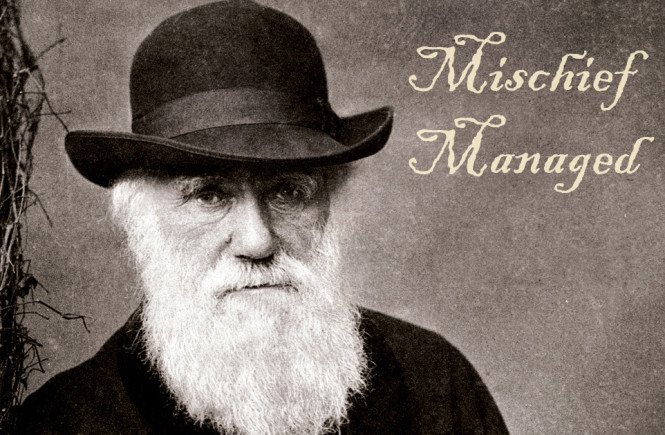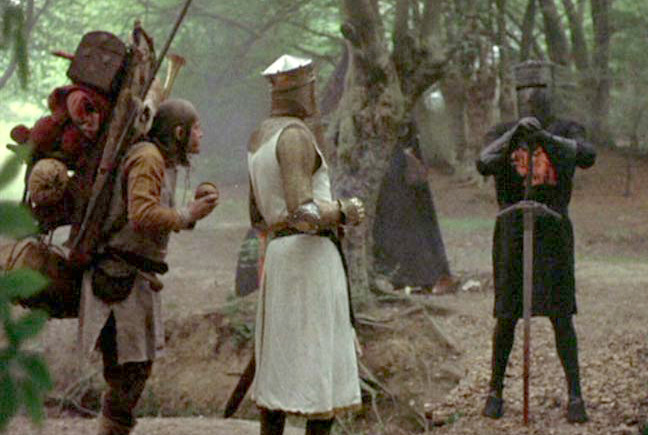Genetics, fan fiction, and the meaning of life
An excellent rule for avoiding conflict in social situations is to avoid any discussion of religion and politics. A recent addendum to this advice would be to also shun discussing the potential love interest of fictional characters, or in the lingo of fan-fiction, “’ships”. An example: in the world of Harry Potter, for many, Harry and Ginny Weasley never marry, though this was established in the final book’s epilogue. For these fans, whose mantra is “Epilogue? What epilogue?” the correct pairings are Harry and Hermione, Harry and Draco Malfoy, or Hermione and Snape (incidentally, I will contend that last one is wrong on multiple levels). Online discussions of the obviousness or absurdity, propriety or unseemliness of these relationships can assume levels of violent self-righteousness that makes one very grateful that these arguments are conducted largely within a demographic with low gun ownership.
Fictional characters engender so much emotion in us because they are incomplete, no matter how good the author is. In fact, good writing is as much as what should be left unsaid as what needs to be written down. The book (or the movie) can only give us a limited set of facts or images. The full character of a character is left unwritten, and it’s our job as readers to fill this in. Therefore it is the act of reading, when we fill in the blanks with our own visions, that gives the characters real meaning. And when our visions of a character’s personality are denied in book five, or in episode four of the second season, or the epilogue, or even in someone else’s fan fiction, it’s a personal attack. We’ve created the characters in our image, and vested them with our own visions of what they mean to their fictional world, and now that is being annulled. And in the cases of those writing any romances which involve Dumbledore, those fan fiction versions of the character are also just plain wrong.
Except for cereal boxes and magazine covers, most things in our life don’t readily tell us their inner substance
It’s not just the inner life of fictional characters that are left to our own efforts to create. In fact, barring the descriptions on boxes of breakfast cereal, most things in our life don’t have their complete meaning handed to us in large text and colorful pictures. It is by filling in these blanks, by creating meaning in our life where there was no obvious meaning before, that we define ourselves. This is why we are so sensitive to disagreement on some subjects. Our politics describes how we believe we ought to live together as a society, and what our roles and duties to our community entail. Our philosophy and religion tells us how we relate to the whole universe. Encountering others with differing views means either that one of us is wrong, or that we need to build a tent for our world views that is big enough to house all these contrary stories. Choosing the former is usually the easiest choice, with the other person being the one that is wrong, of course.
We do much of this creation of meaning via storytelling, we create or share narratives that describe our beliefs. Stories about past kings or presidents that exemplify our best attributes, or stories about events, historical or mythical, that describe our place in this world, are all integral to how we understand ourselves. Arthur and his Round Table illustrate bravery and fairness, Moses and the Pharaoh describes steadfastness and justice, and King Charles hiding in the oak tree reminds us that even kings sometimes have to hide in trees (actually I’m not sure of the meaning of this legend, but it’s a good story). Similarly our preferences in fiction, whether it’s political thrillers, science fiction, mysteries, or romance novel, and whether we believe that Harry and Hermione are bound by fate to marry one day, describes, ultimately, our personal desires and hopes.
Science is supposed to be immune to the emotional stress created by our search for meaning. Opinion, personality, and ego are meant to be left out of the scientific process. Instead, we create objective, testable hypotheses to explore what we’re studying, and then perform an experiment so see if the hypothesis is correct. Narrative is not a part of the process. This doesn’t mean that we’ve taken personality out of our discipline, but at least we’ve put some shackles on how much importance it is supposed to have. ‘Supposed’ is the operative word in that last sentence, as science can often have melodrama at Brontë sisters/reality TV levels. When Jim Watson, one of the leaders of the projects to sequence the human genome, has to release a statement that he hadn’t been trying to call another scientist a monkey, per se, it’s clear that some emotion still creeps into our discipline.
Science has sometimes faltered when we couldn’t easily frame a testable hypothesis; the origin of the universe and the origin of species are two examples.
This banishment of narrative from science falls apart when we don’t know how to frame a testable hypothesis, especially when it looks like there should be a scientific approach to the problem. One example: the origin of the universe. This is a subject that physics gets us frustratingly very close to addressing, but ultimately fall short. The physical forces we can measure are understood to have emerged around 10−12 seconds after creation. That’s one tenth of one tenth of one tenth…(repeat eight more times)… of one tenth of a second. In that amount of time light can travel only about one third the thickness of a dime, so you might think that not much could have happened during that 10−12 seconds. However the early universe was a busy time, and during that fraction of a second the basic physical forces that govern everything since then were getting resolved. This means that we can’t know much about what happened before 10−12 seconds has passed as we can’t test how things worked at that time. We have a variety of conjectures for what happened in that fraction of a second, but not much in the ways to address these theories experimentally.
This doesn’t mean that we should compare theories that scientists use to describe what may have happened during that 10−12 seconds to the realm of fiction. Kipling’s ‘Just So’ stories, like the one about how the camel got its hump, or the leopard its spots, are different, fundamentally, than string theories or the idea of the multiverse. Nonetheless, their shared reliance on a reasonable sounding narrative is possibly more important than many physicists may want to acknowledge. As for what happened before T=0…, science fiction is as good of a tool as science. And religion too, of course, has several strong opinions about this period as well. However new ideas and new technologies have let us push back on this barrier to understanding the early universe, and it’s not unreasonable to suppose that we may soon have testable ideas that bring us all the way to T=0.
The origin of species is another topic that looks scientific, but for a long time we couldn’t frame an explanation in a testable manner. In the West, ideas on the origin of species were largely based on the book of Genesis in the bible, and on Aristotle’s metaphysics. Genesis contains two different but complimentary origin stories that describe the beginning of life largely in allegorical terms. Aristotle thought that life on Earth existed for the sake of realizing its potential. This was an idea that the early Church scholars, such as Thomas Aquinas, embraced in the Middle Ages. Like the stories of Genesis, Aristotle’s metaphysics attributes purpose and meaning to the differences we find in life forms. Animals swim or fly or crawl, or are edible or inedible, because they are meant to swim or fly or crawl or be eaten. That is their purpose.
The camel’s hump may not exist because it said “humph”, but it surely has a purpose, right?
This is an attractive explanation. With this philosophy, meaning is attributed to all life, and to all aspects of living things. The camel may not have a hump because, as Kipling claimed, it said, “humph” too frequently, but it surely has some purpose. The spots on a leopard likely exist for the purpose of allowing the leopard to hide from its prey. Similarly, the large portions of my brain devoted to Star Trek trivia, as opposed to knowledge that would actually help me in most facets of my life, is not because I lack direction and ambition, but possibly because my purpose in life is to be able to correct people when they confuse the Cardassian/Klingon alliance from the mirror universe with the Klingon/Federation alliance against Cardassia (a common source of confusion). OK, maybe that last is a bit of wishful thinking, but the ability to attribute purpose to life is definitely alluring.
Georges Cuvier was an influential scientist of the early 19th century who helped define methods for classifying species based on their anatomy. His encyclopedic knowledge of anatomy often allowed him to identify a specimen from a single bone. The pelvis of a predator is different than the pelvis of a plant eater because all parts of our body are intricately fit together, and differences in one part of the body, such as having powerful jaws and legs, will have consistent effects on all other parts of the body. Like Aristotle, he espoused a view of the origin of species that focused on purpose. It’s told that one of his students, dressed as the devil, surprised him in his sleep, yelling, “I am the Devil. I have come to devour you!” Cuvier studied the apparition and replied, “I doubt whether you can. You have horns and hooves, and thus you eat only plants.” Cuvier believed that the perfect fit, as he saw it, of anatomical form to function meant that species could not change, as any alteration of a species’ anatomy would move that aspect of their body away from its ability to perform its function.
Charles Darwin began work on an explanation for the origin of species about the time of Cuvier’s death. His theory, evolution through natural selection of existing variation within species, did away with the need to attribute purpose to species, or even to our anatomy. Darwin, in brief, supposed that variation in a species is heritable, and that animals with variations that give them a survival edge over their compatriots will have more offspring. Their children will carry those traits that gave they parents an edge, and if the selection pressure stays the same, their offspring are also more likely, in turn, to have more offspring than other members of their species.
We now know that the heritable variation on which his theory depends is described by genetics, which was a missing piece at the time that Darwin described his theory. Variation in the sequence of a gene from one organism to another can result in changes to the structure of the protein it produces, or changes in when or how much a protein is produced. Most of the genome projects currently underway now focus on describing this genetic variation between people, and trying to discern what effects these gene variants have on our bodies.
Contrary to Kipling’s “Just So” stories, Darwin’s vision of evolution says that we can describe a benefit of the leopard’s spots, but we can’t talk about their purpose.
And thus, with the addition of genetics, a complete theory of evolution is now available. Genetic variation exists in great abundance in all species, which results in the differences we can see between and within species. Natural selection for animals exhibiting favorable variation will thus allow the selected genetic variants to accumulate over time in a species. The perfect fit of form to function that Cuvier found isn’t, therefore, because the purpose of a wolf’s tooth is to kill, but because wolves with gene variants that allowed for sharper and stronger teeth were better able to have more little wolves, and thus pass on their traits.
It was this divorce of meaning and purpose from biology that has caused many to so stridently reject Darwin’s idea. Evolution through natural selection removes any sense that there is a prescriptive ‘ought’ to our life, only a descriptive ‘is’. Before Darwin, all aspects of life seemed easily fit into narratives about design, meaning and purpose. For many, this seems to do away with a role for God in the design of life. Even setting aside the religious implications, the implications of Darwin’s theory are still unsettling. With his theory in hand, it appears that the meaning we attribute to life are simply stories that we have made, but that don’t truly explain life. Not, at least, from a scientific perspective. Like having our plans for Harry Potter denied in the epilogue, Darwin threw out all the stories we had made explaining life on Earth. This isn’t easy to accept. It seems too random, directionless. Not only are our stories denied, but nobody is writing the story at all.
Furthermore, in Darwin’s explanation of evolution we can’t evolve towards a function. Instead, genetic variants that give a species a slight edge are selected for, but where this will lead to over time is anybody’s guess. The leopard did not develop spots in order to be able to hide. Instead, we would say that the leopard’s ancestors who had some spots were able to hide better than their compatriots without spots, and thus had more offspring (with spots). So not only does Darwin’s theory mean that we can’t say that the wolf evolved sharp teeth in order to eat sheep, but we can’t say that there is any direction to the tree of life. Wolves, just because they eat sheep, are not more advanced than sheep. Similarly, and more difficult for some to accept, we also can’t say that humans are ‘more evolved’ or more advanced than apes, or any other species for that matter. Not even Trump supporters. All we can say is that our species has differences from our ape-like forbearers that allowed our ancestors a breeding advantage.
Modern biology has not completely detached itself from a belief in purpose. As discussed previously, we often name genes as if we can discern their purpose, despite most proteins having multiple possible functions. For example, the enzyme ‘cyclin-dependent kinase 1’ is also known as ‘cell division control 2’. The first name describes a function, while the second name implies a purpose. ‘Cyclin-dependent kinase 1’ is now the official name, but many genes still have names that suggest a clear role or purpose for them in our cells.
This isn’t to say that there is not a meaning to life. Just don’t ask a geneticist to tell you what it is. Fortunately, we’re rarely asked.
Is there an underlying structure to our universe that provides meaning to life? Darwin’s theory doesn’t really address that, it just means that we can’t look at how fit things seem to be, like eagles to flying, dolphin’s to swimming, or Harry to Hermione, and the declare that this then shows that there is purpose to the distinctive features of these beasts. Darwin’s theory doesn’t say there isn’t a clear meaning of life, just that the matching of form to function doesn’t show evidence of meaning. It just is.
And of course, even if biology has been able to mostly shed itself of a belief in purpose, this doesn’t spell the end of meaning from all walks of our life. We are free to create our own purpose, of course. As Sartre said, we are condemned to be free. Politics is still the art of getting everyone to agree on a purpose, and then, often much more difficult, plan how to get us to that goal without killing each other (that last clause is frequently not seen as necessary). Religion is body of practices and philosophies that also help us use the notion of purpose to direct our lives. However if we’re confining ourselves to just the realm where biology and genetics can have a say, then we are left with a world without a given purpose or meaning.
Of course, we always have our fan fiction too allows us to explore meaning. Just leave the Hagrid and Hermione, Luke and Leia, and Mulder and Scully pairings aside, please.



